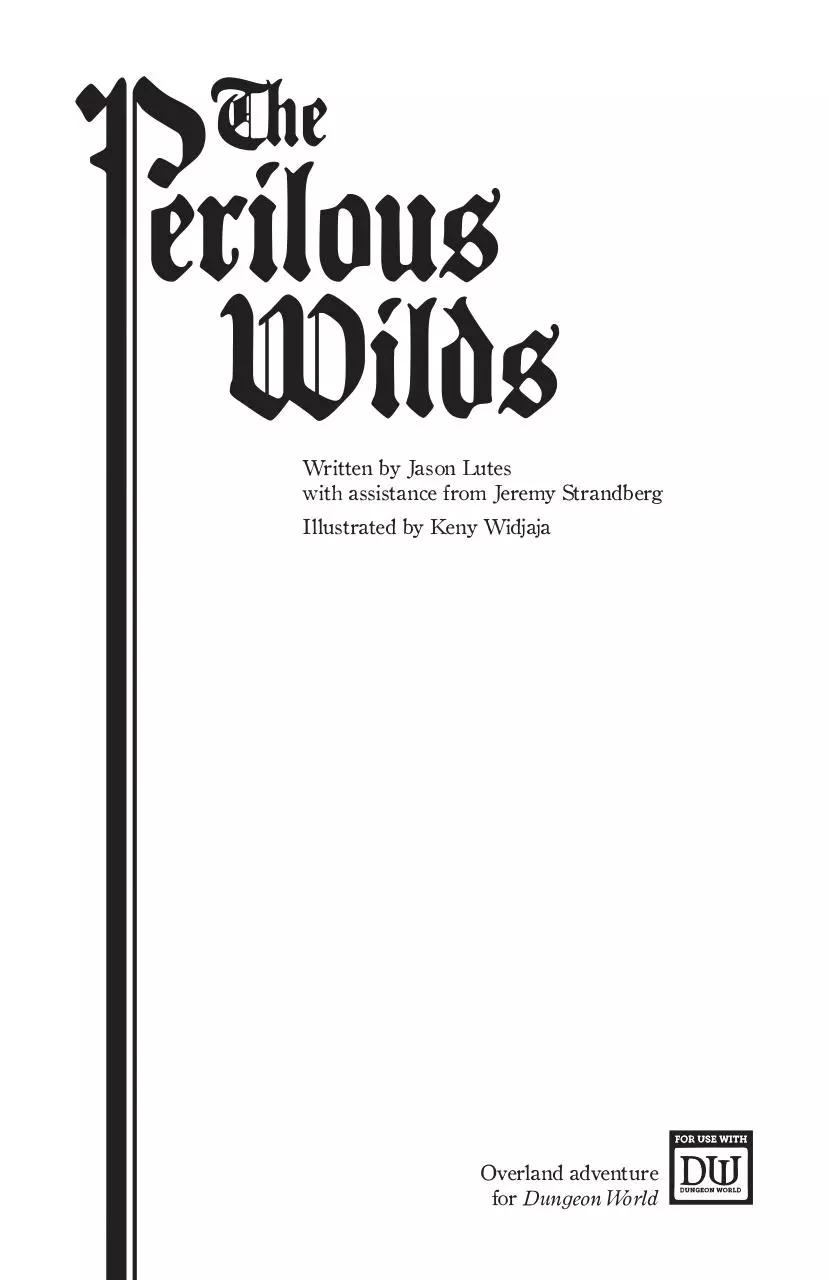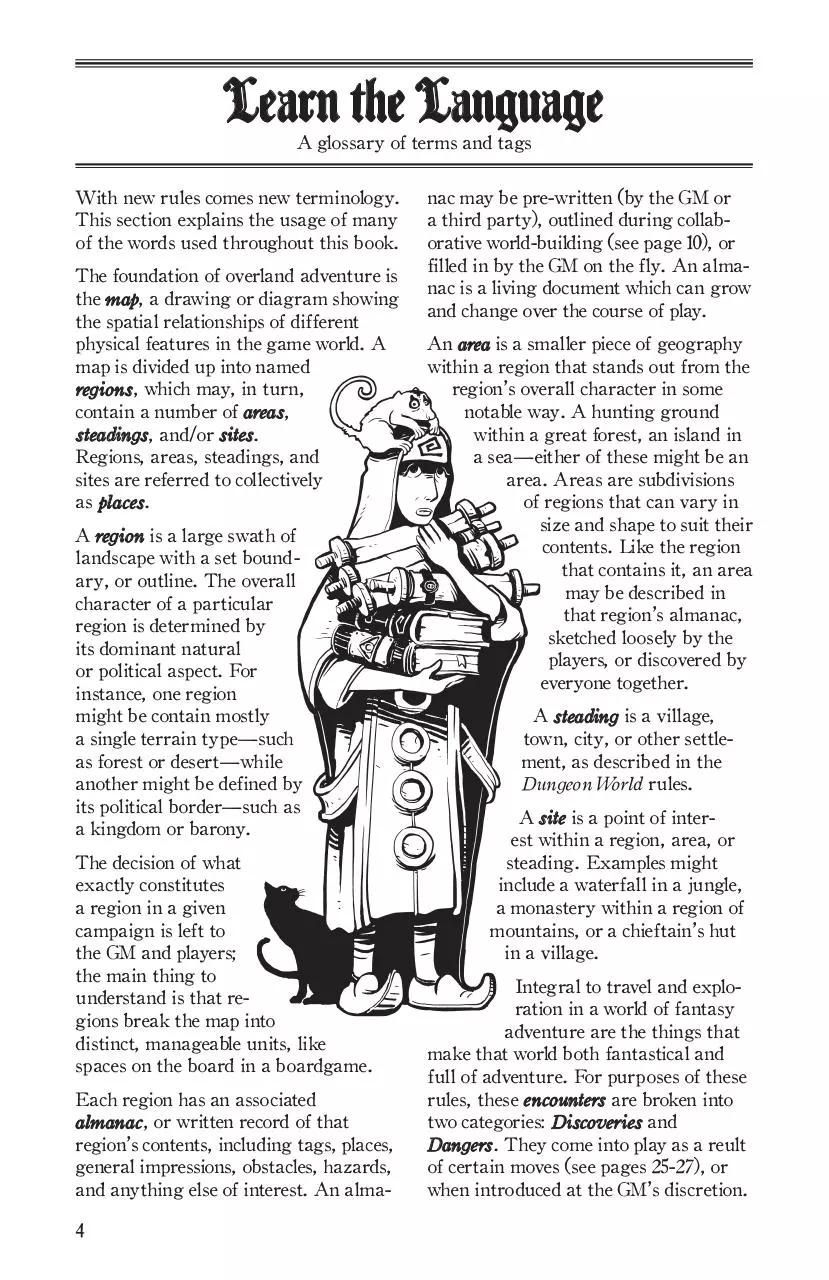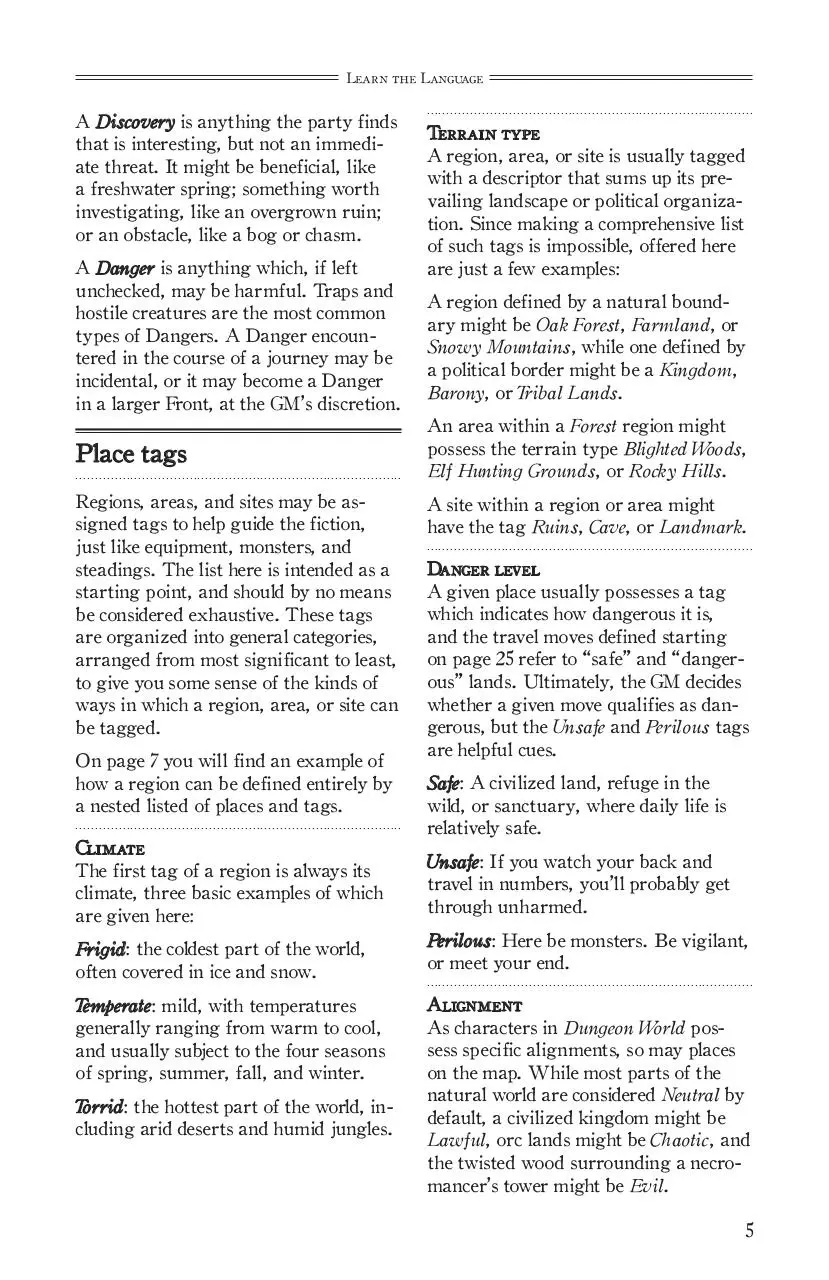( uploadMB.com ) DungeonWorld Perilous Wilds (PDF)
File information
Title: The Perilous Wilds.indd
This PDF 1.3 document has been generated by Adobe InDesign CS4 (6.0) / Adobe PDF Library 9.0, and has been sent on pdf-archive.com on 13/12/2017 at 23:01, from IP address 108.53.x.x.
The current document download page has been viewed 8302 times.
File size: 11.32 MB (72 pages).
Privacy: public file





File preview
The
erilous
Wilds
Written by Jason Lutes
with assistance from Jeremy Strandberg
Illustrated by Keny Widjaja
Overland adventure
for Dungeon World
Contents
----------------------------------------------------------------------------------------
Introduction........................................................ 3
Learn the Language
A glossary of terms and tags................................... 4
Draw the Map
Making the world together.................................... 10
Lead the Way
Rules for hirelings and followers.............................. 18
See the World
Traveling from place to place.................................. 24
Weather the Storm
Simple moves for handling weather......................... 32
Live to Tell the Tale
Compendium classes............................................ 34
Ask the Fates
Rolling dice to reveal the unknown......................... 40
Plumb the Depths
Building dungeons on the fly................................. 54
Trust Your Gut
Agenda and Principles for the GM........................... 62
Name Every Person
A collection of cultural name lists........................... 66
2
Introduction
...................................................................................
This supplement details a system for creating and exploring a campaign setting
using the Dungeon World rules. As such,
it presumes familiarity with those rules.
Herein you will find guidelines for
building a world from scratch, fleshing
out the geography of a preexisting setting, and/or exploring terra incognita on
the fly; new rules for wilderness travel,
exploration, and hiring followers; a system for generating random encounters;
and a variety of other resources.
Many of these different rules are codependent, but not inextricably so. You
should find it easy to choose which ones
you want to incorporate into your own
play, and which ones to ignore.
----------------------------------------------------------------
Ask, say, or roll
...................................................................................
Underlying nearly every aspect of this
rules supplement is a basic philosophy of
collaborative world-building that can be
summarized as “ask, say, or roll.”
A particular strength of Dungeon World
is the way in which the Principle “ask
questions and use the answers” shifts
creative responsiblity partly off the GM
and helps players become invested in the
world of the game. With that in mind,
the first step of world-building in The
Perilous Wilds is ask.
The GM should ask the players questions
about the their characters and their
surroundings whenever she feels like it,
knowing that every answer deepens the
involvement of everyone at the table.
Some believe that, in the interest of
player immersion, the GM should only
ask a player a question to which their
character might conceivably know the
answer; others treat any question as
fair game, making the players and GM
co-authors at close to the same level.
Wherever your group falls on this spectrum of play, if a question that demands
an answer arises, someone (usually the
GM) should probably ask it.
If there is no desire or call for a question, but the fiction demands advancement, it becomes someone’s job (again,
usually the GM’s) to say: to use her
knowledge of the fiction-to-date and
improvisational instincts to flesh out the
world, define the circumstances, narrate
the next step. The GM need not be the
ultimate authority, but does hold the
office of narrative failsafe: the one who
takes up the threads spun by everyone
at the table and weaves them into the
greater whole.
But when asking won’t work, the GM is
at a loss for words, or the simple urge to
mix things up is felt, you are exhorted
to roll.
Rolling dice for moves is already integral to seeing what happens in a game
of Dungeon World, and The Perilous
Wilds adds more opportunities for rolling by introducing a host of randomized
prompts to push the fiction in unexpected directions.
Because when no one knows the answer
before the dice are rolled, the sense of
discovery is heightened. And given its
focus, this would be a poor supplement
indeed if that feeling were not exploited
to its fullest.
3
Learn the Language
A glossary of terms and tags
With new rules comes new terminology.
This section explains the usage of many
of the words used throughout this book.
The foundation of overland adventure is
the map, a drawing or diagram showing
the spatial relationships of different
physical features in the game world. A
map is divided up into named
regions, which may, in turn,
contain a number of areas,
steadings, and/or sites.
Regions, areas, steadings, and
sites are referred to collectively
as places.
A region is a large swath of
landscape with a set boundary, or outline. The overall
character of a particular
region is determined by
its dominant natural
or political aspect. For
instance, one region
might be contain mostly
a single terrain type—such
as forest or desert—while
another might be defined by
its political border—such as
a kingdom or barony.
The decision of what
exactly constitutes
a region in a given
campaign is left to
the GM and players;
the main thing to
understand is that regions break the map into
distinct, manageable units, like
spaces on the board in a boardgame.
Each region has an associated
almanac, or written record of that
region’s contents, including tags, places,
general impressions, obstacles, hazards,
and anything else of interest. An alma4
nac may be pre-written (by the GM or
a third party), outlined during collaborative world-building (see page 10), or
filled in by the GM on the fly. An almanac is a living document which can grow
and change over the course of play.
An area is a smaller piece of geography
within a region that stands out from the
region’s overall character in some
notable way. A hunting ground
within a great forest, an island in
a sea—either of these might be an
area. Areas are subdivisions
of regions that can vary in
size and shape to suit their
contents. Like the region
that contains it, an area
may be described in
that region’s almanac,
sketched loosely by the
players, or discovered by
everyone together.
A steading is a village,
town, city, or other settlement, as described in the
Dungeon World rules.
A site is a point of interest within a region, area, or
steading. Examples might
include a waterfall in a jungle,
a monastery within a region of
mountains, or a chieftain’s hut
in a village.
Integral to travel and exploration in a world of fantasy
adventure are the things that
make that world both fantastical and
full of adventure. For purposes of these
rules, these encounters are broken into
two categories: Discoveries and
Dangers. They come into play as a reult
of certain moves (see pages 25-27), or
when introduced at the GM’s discretion.
Learn the Language
A Discovery is anything the party finds
that is interesting, but not an immediate threat. It might be beneficial, like
a freshwater spring; something worth
investigating, like an overgrown ruin;
or an obstacle, like a bog or chasm.
A Danger is anything which, if left
unchecked, may be harmful. Traps and
hostile creatures are the most common
types of Dangers. A Danger encountered in the course of a journey may be
incidental, or it may become a Danger
in a larger Front, at the GM’s discretion.
Place tags
...................................................................................
Regions, areas, and sites may be assigned tags to help guide the fiction,
just like equipment, monsters, and
steadings. The list here is intended as a
starting point, and should by no means
be considered exhaustive. These tags
are organized into general categories,
arranged from most significant to least,
to give you some sense of the kinds of
ways in which a region, area, or site can
be tagged.
On page 7 you will find an example of
how a region can be defined entirely by
a nested listed of places and tags.
...................................................................................
Climate
The first tag of a region is always its
climate, three basic examples of which
are given here:
...................................................................................
Terrain type
A region, area, or site is usually tagged
with a descriptor that sums up its prevailing landscape or political organization. Since making a comprehensive list
of such tags is impossible, offered here
are just a few examples:
A region defined by a natural boundary might be Oak Forest, Farmland, or
Snowy Mountains, while one defined by
a political border might be a Kingdom,
Barony, or Tribal Lands.
An area within a Forest region might
possess the terrain type Blighted Woods,
Elf Hunting Grounds, or Rocky Hills.
A site within a region or area might
have the tag Ruins, Cave, or Landmark.
...................................................................................
Danger level
A given place usually possesses a tag
which indicates how dangerous it is,
and the travel moves defined starting
on page 25 refer to “safe” and “dangerous” lands. Ultimately, the GM decides
whether a given move qualifies as dangerous, but the Unsafe and Perilous tags
are helpful cues.
Safe: A civilized land, refuge in the
wild, or sanctuary, where daily life is
relatively safe.
Unsafe: If you watch your back and
travel in numbers, you’ll probably get
through unharmed.
Frigid: the coldest part of the world,
often covered in ice and snow.
Perilous: Here be monsters. Be vigilant,
or meet your end.
Temperate: mild, with temperatures
generally ranging from warm to cool,
and usually subject to the four seasons
of spring, summer, fall, and winter.
Alignment
As characters in Dungeon World possess specific alignments, so may places
on the map. While most parts of the
natural world are considered Neutral by
default, a civilized kingdom might be
Lawful, orc lands might be Chaotic, and
the twisted wood surrounding a necromancer’s tower might be Evil.
Torrid: the hottest part of the world, including arid deserts and humid jungles.
...................................................................................
5
Learn the Language
...................................................................................
Other tags
A place can have as many or few tags
as its writer cares to add. Place tags can
be thought of as a kind of shorthand for
what might otherwise be paragraphs
of descriptive text. Following are some
examples; you are encouraged to invent
more as needed.
Barren: lacks abundant water and fertile
soil. Foraging (see page 25) on Barren
terrain is difficult.
Blighted: cursed, poisoned, or diseased
by some malificent force.
Civilized: possesses cultural, social, and/
or economic infrastructure that has
withstood the test of time.
6
Contested ( ____ / ____ ): claimed as
property by two or more parties, i.e,
“Contested (Hawk Tribe/Bull Tribe).”
Defensible: fortified or possessing natural defenses (cliffs, high ground, etc.)
Difficult: hard to traverse (swampland,
dense jungle, steep hills, etc.).
Enchanted: imbued with arcane energy
that causes some particular effect.
Holy or Unholy: blessed by some divine
power or stained by blasphemy.
Property ( ____ ): owned by an entity,
i.e., “Property (King John)”.
Resource ( ____ ): contains a substantial
amount of something valuable and extractable (gold, timber, crops, etc.), i.e.,
“Resource (iron).”
Learn the Language
~ Example ~
Abbreviated Almanac
--------------------------------------------------------------------------------------------------------------------------
This abbreviated almanac is provided as an example of how places can be
tagged and nested within one another. In this case, the region is defined by a
political boundary—it’s a kingdom—as opposed to a prevalent terrain. See
the following page spread for an example of a more detailed almanac.
................................................................................................................................................................
Region - Otthon (“Home of the People”)
Human Kingdom, Unsafe, Lawful, Civilized
................................................................................................................................................................
Area - County Lazlo
Farmland, Safe, Lawful, Civilized, Resource (marble)
Steading - Whitestone
Human Town, Safe, Lawful, Civilized, Moderate, Growing, Guard,
Religion (Tuzhela), Personage (Count Lazlo, High Priestess
Antonia, Szabol the Smith), Enmity (Fenkin Village)
Site - Whitestone Keep
Keep, Safe, Lawful, Civilized, Defensible
Site - Church of Tuzhela (Goddess of Home and Hearth)
Temple, Safe, Lawful, Civilized, Holy
................................................................................................................................................................
Area - Heartwood
Forest, Unsafe, Neutral, Resource (game), Property (Count Lazlo)
................................................................................................................................................................
Area - The Fell-Fen
Wetland, Perilous, Neutral, Difficult, Contested (Count Lazlo/Chief
Yellow Eye)
Steading - Fenkin Village
Fenkin Village, Perilous, Neutral, Poor, Steady, Watch, Religion
(Vaank), Personage (Chief Yellow Eye, Swamp-Doctor Rillik),
Enmity (Whitestone)
Site - Shrine of Vaank (Salamander god of Wetlands)
Shrine, Neutral, Holy
Site - Bogbeast Burrow
Lair, Perilous, Neutral, Difficult
7
Learn the Language
~ Example ~
Detailed Almanac
Chalkwood Downs
Temperate, Wooded Highland, Perilous, Neutral
----------------------------------------------------------------
Details
...................................................................................
U Severe, rocky hills
U Jutting slabs of pale stone
U Sparse, slender, white-leaved trees
U Roots like snakes, reaching into rock
U Knee-high yellow grass
U Spring: carpet of pale yellow flowers
U Summer: Pale stone, blindingly bright
U Fall: Leaves, black and drifting
U Winter: Ceaseless wind, like a knife
of ice
----------------------------------------------------------------
Discoveries
...................................................................................
Area . Skysplitter
Perilous, Neutral
A needle-like spire of rock, rising aberrantly from the surrounding downs, visible at a great distance, always further
away than it appears.
U What does local legend say about
Skyplitter’s needle-like appearance?
U What are the roots of the mountain
said to embrace?
U What calls Skysplitter’s peak home?
...................................................................................
Encounter . Missionaries
Good
A pair of priests escorted by four members of a holy fighting order, seeking
to establish a shrine on the slopes of
Skysplitter.
...................................................................................
Site . The Ribs
Unsafe, Neutral
A colonnade of curved white pillars
resembling the ribcage of some great
beast, half-submerged in the earth.
8
...................................................................................
Area . Delver’s Defile
Perilous, Evil
A narrow ravine slicing fifty feet down
through rock to a clear trickle of water.
A desiccated corpse is wedged in a narrow spot halfway down. Upstream, the
water emerges from a break in the rock
that opens into a natural cave system.
Something glitters in the streambed.
When you venture into the caves of
Delver’s Defile, roll +WIS: on a 10+, You
find your way to the vein of precious
metal deep within, but getting out is
another matter; on a 7-9, you encounter
a foul denizen or deadly hazard (ask the
GM what).
...................................................................................
Site . The Toothy Stair
Perilous, Neutral
A natural stair ascending a cliff face,
each step a sharp edge of rock that allows an easy to climb for the well-shod,
but poses a potentially crippling hazard
to anyone who loses their footing.
...................................................................................
Site . White Walker Den
Perilous, Evil
Two large openings side-by-side in a
rocky hillside overlooking a wooded vale
lead into a set of caves which are home
to a mated pair of White Walkers.
During the day the creatures stay deep
within; at night one or the other goes
hunting. Amongst the detritus in their
“trophy room” is the Seal of Sardoza.
...................................................................................
Treasure . Seal of Sardoza
1 weight, 200 coins
A stone disc one hand wide, carved with
an ancient seal: a stag’s skull wreathed
in thorny vines. Of great value to collectors, historians, or scions of Sardoza.
Learn the Language
----------------------------------------------------------------
Dangers
...................................................................................
Site . Ghost Hollow
Perilous
On warm mornings in winter and
spring, thick mist fills the hollows and
vales of the Downs. In one such depression, the mist grows so thick that it
obscures the presence of a deep crevice
narrow enough to leap across, but
deadly to any who step into it unawares.
When you cross Ghost Hollow on a
misty morning, roll +WIS: on a 10+, You
notice the drop, and not a moment too
soon; on a 7-9, you step into it, but you
have a split-second to save yourself from
falling to a fate of the GM’s choosing.
What do you do?
...................................................................................
Monster . Marrowsup
Horde
Damage Beak 1d4 (hand, 1 piercing)
HP 2 Armor 0
Special Qualities Winged
Gray-feathered carrion birds known to
attack the wounded as well as the dead.
Instinct To feed upon death and injury
U Swarm them
U Savage a preexisting injury
U Pierce to the bone, and hang on
...................................................................................
Monster . White Walker
Solitary, Large
Damage Sickle-like claws 1d10+2 (reach,
messy, forceful)
HP 16 Armor 2
Special Qualities Vulnerable to fire and
sunlight
Bone-colored bipeds that stalk the
Downs at night like the ghosts of giants.
Their bellowing can be heard echoing
from ridge to ravine at dusk and dawn.
Instinct To gorge on living things
U Regenerate by consuming flesh
U Seize them
U Hurl them away
9
Download ( uploadMB.com ) DungeonWorld Perilous Wilds
( uploadMB.com ) DungeonWorld Perilous Wilds.pdf (PDF, 11.32 MB)
Download PDF
Share this file on social networks
Link to this page
Permanent link
Use the permanent link to the download page to share your document on Facebook, Twitter, LinkedIn, or directly with a contact by e-Mail, Messenger, Whatsapp, Line..
Short link
Use the short link to share your document on Twitter or by text message (SMS)
HTML Code
Copy the following HTML code to share your document on a Website or Blog
QR Code to this page

This file has been shared publicly by a user of PDF Archive.
Document ID: 0000708311.